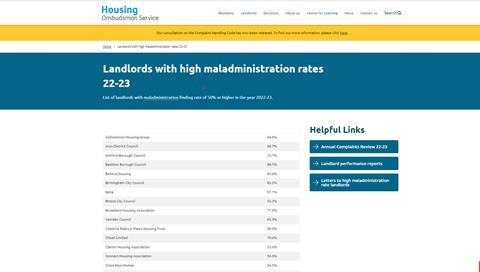Housing figures raise concerns about Housing Ombudsman’s ‘misuse’ of statistics to publicly rate landlords
Six complaints have been made to the Office for Statistics Regulation (OSR) about the Housing Ombudsman’s “maladministration rate” used to assess and rank social housing providers on their quality of service to residents.
The OSR’s latest issues log has been updated to show six separate concerns received by the watchdog in the past three weeks.
The complaints were made following the Housing Ombudsman’s annual complaints review published on 17 October, as part of which it published a list of social landlords with a maladministration rate of 50% or higher.
See also >> Housing Ombudsman reveals 323% increase in severe maladministration findings
See also >> Clarion completions down 23% year-on-year
The OSR issues log does not detail the exact nature of the complaints, however, several senior housing figures told Housing Today of their concern over the way the ombudsman is using the data, particularly in its list of social landlords with high maladministration rates.

One housing figure said the use of an overall maladministration rate is like comparing “apples with pears”.
The maladministration rate is calculated by adding together three different types of failings.
It adds together service failures, which are considered more minor failings, maladministrations, in which a resident has been adversely affected and a severe maladministration, considered the most serious.
These are then added together and divided by total findings to give a landlord’s maladministration rate.
The table published by the Ombudsman does not however give a breakdown of the severity of the findings, nor does the overall figure take into account the number of homes a landlord is managing.
“The indicators need to be measured separately, and they need to incorporate the size of the organisation”, a senior figure in the sector said.
One chief executive of a large housing association referred to the list of landlords with high maladministration rates 22-23 as a “misuse of statistics”.
“If a small landlord has two findings overall and both are maladministration for 5,000 homes, it’s a maladministration rate of 100% but it seems absurd to put that in a league table”, they said.

Conversely, a larger housing association may receive 100 findings, 50 of which are maladministrations, producing a 50% maladministration rate.
Another senior housing figure pointed out that “quite a lot of weight” is placed on the maladministration rate.
The Ombudsman uses it to make his judgment, and it is one of the measures used to decide whether a “paragraph 49”, special investigation is launched. Yet it is “self-evidentially flawed”, he said.
A paragraph 49 investigation gives the Ombudsman the ability to conduct systemic or thematic investigations beyond an individual complaint or landlord.
Alistair McIntosh, chief executive of Housing Quality Network (HQN), urged the sector however to focus on improvement rather than dispute the statistical methods used.
“We can take an Alan Turing approach and latch on to the Ombudsman’s percentages and the fact they could tarnish the sector’s reputation, or we can focus on the real issues and work on getting better as a sector”, he said.
The Ombudsman’s review last month showed a 323% increase in severe maladminstration findings.
An OSR spokesperson ruled out the body investigating the concerns as the ombudsman rate is not classed as an official statistic within its remit.
A Housing Ombudsman Service spokesperson said it is “confident in its approach to openness in its use of maladministration statistics.”
He said: “Our openness with data holds landlords to account and gives them a greater ability to learn from not only their own decisions but also those of their peers.
“During the creation of the Annual Complaints Review landlord reports, every landlord receives a draft of their report prior to publication which provides them an opportunity to comment and seek clarifications. This gives landlords several months for their comments to be incorporated and ensure the robustness of the data.
“We regularly engage with landlords and have a positive experience of working through figures and welcome those conversations when they do arise.”










No comments yet